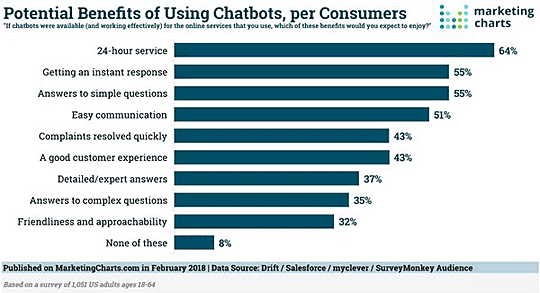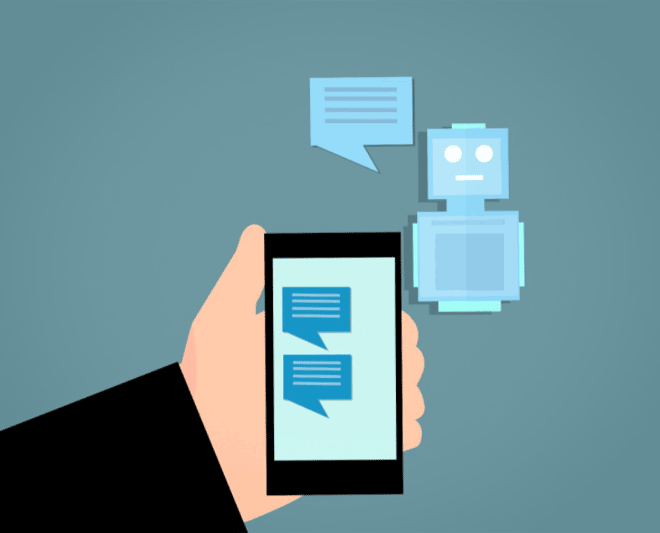With a plethora of technologies emerging and spinning around the market, it has become much more challenging for entrepreneurs to determine which one to use and why? This is specifically true in the case of advanced technologies like Artificial Intelligence (AI) and one of its primary brainchild chatbots.
As per the report provided by Drift, chatbots have a huge user base in the US but they have yet to find broad appeal among consumers. Let’s look at a few of the major benefits of these bots for US consumers in the image by Marketingcharts.Com:
Consumers still want their complex problems to be addressed by a human. But why do they need more humanity and less automation? Are chatbots not providing them with efficient support? Or, are they proving out to be incompetent in resolving their issues?
Let’s find out how these Artificial Intelligence powered tools really help your prospects or customers. Also, we will explore a few ways through which these bots can be improvised to boost customer experience.
1. Make Chatbots Capable To Handle More Than Just Generic Queries: Set-Up An Escalation Path
Basically, chatbots answer generic queries of your customers. They are built to deal with routine questions quickly. In case of complex questions, the majority of the bots have a choice to escalate the communication to a human customer service agent. The professional has to understand the entire thread of the conversation which has happened between the customer and the bot. Also, they need to identify the right time to switch the call from a chat window to a voice interface.
This is not at all easy. But if you really want to make the process much more streamlined, then its needed to set up a proper escalation path. This is essential because if the customer will be unsatisfied with the way you have handled their query, they might decide to dump your brand.
It is mandatory to design chatbots by keeping a comprehensive plan to manage escalations. Also, these bots should have the ability to minimize the waiting time for customers and ensuring that they are provided with suitable support services.
2. Follow Empathetic Approach To Make Bots Less Robotic
One of the major drawbacks of these bots is that they might sound very robotic to the customers. They might find it difficult to express their true emotions because these tools lack empathy.
This is the major reason why you should consider making these bots empathetic. These bots should be able to identify customer sentiments and modify the flow as well as the tone of the conversation accordingly. At the end of a conversation, chatbots must ask customers how they’re feeling? This will give a human touch to the process by training bots to take appropriate action in response to diverse emotional situations and emotions.
3. Leverage Natural Language Processing (NLP) To Make Bots More Friendly
The chatbots are friendly but not to the extent which is required. Therefore, you should try to make them friendly without being interfering. They should be built to act in accordance with the tone of the customer. NLP allows bots to identify the real language and by analyzing the data software tries to give personalized solutions to the customers.
But the capability of chatbots can be enhanced so that it can recognize the tone of the customers. They should have the potential to use an informal tone in order to provide customers with an interactive experience. Also, bots must be able to offer insights into the type of customers visiting the site and the common issues they are having.
4. Keep Upgrading Chatbots With New Information At Regular Intervals Of Time
Chatbots can’t be static and hence you should be very careful when implementing and maintaining them. These solutions are quite expensive and to manage these is quite a task. Also, it’s equally important to keep them feeding with new information so that they can be up to date.
Bots become redundant if you ignore to supply them sufficient data, train them, or give them the necessary space and tools to evolve. Therefore, it’s the primary objective to keep your bots alive by feeding them with new data frequently.
5. Design Chatbots To Be The Mouthpiece For Recruitment
Chatbots can be enhanced to streamline the hiring process for HR professionals. Especially these tools can help recruiters in screening and examining engineering resumes easily as well as efficiently. Also, these software professionals are more comfortable in adopting advanced technologies like chatbots compared to employees belonging to other streams.
Your recruitment chatbot can reach out to potential programmers and walk them through the application process by engaging with them in a conversational tone. This will prevent engineers from the hassle of filling cumbersome and lengthy online job application forms.
For instance, Crowded which is a sourcing and engagement platform for tech jobs has recently introduced a recruitment-specific chatbot that has the potential to engage in real conversations with developers and makes the hiring process much convenient for HR.
6. Exploit The Super Power Of Data
By 2020, the majority of customer interactions will be dealt with chatbots. This is making it even more important for you to level up the game and learn from customer conversations. Use Machine Learning (ML) and neural networks to exploit the potential of data and analyze the results. This will allow you to train chatbots how they should interact and respond to new interactions.
This will reduce the workload of the human customer support professionals and let them focus on more complex and important issues. For example, Zendesk’s Answerbot is capable of using NLP to automatically come up with solutions to the most common queries of the customers.
7. Create More Conversational Bots For Maximizing Sales & Conversions
The way people communicate on phones is entirely different from the way they do it on chats or emails. This is why chatbots must be able to spot these differences and make customers feel satisfied with the communication.
In order to achieve this, you need to build chatbots by using the same communication approach which humans have when interacting. You can use interaction analytics in order to make chatbots able to analyze each and every interaction of theirs. This will let them get an idea of the preferred approaches on different channels and they can learn to adapt accordingly.
Try to make chatbots more conversational so that to make the process of sales more interesting and hassle-free for customers, thus improving conversions that are pushed through and managed in your sales CRM. The majority of the customers abandon their shopping carts because they want to spare themselves from the tedious process of creating a new user account, thus impacting your sales pipeline.
But you can make this process shorter and engaging by incorporating a conversational bot. For example, eBay has introduced a virtual personal shopping assistant named ShopBot. Basically, it makes the entire process of buying more interactive and seamless for customers by guiding them in a conversational tone.
It’s true that chatbots are exceptional at dealing with low-complexity issues but in order to make them more efficient, you need to understand their limitations and try to fill those gaps to make them more human.
[Images – Main & Robot woman: Pixabay, Pixabay by Geralt; Chatbot graphic: pxhere; Robot man: Pixabay]
Elise is an experienced web developer at WPCodingDev Ltd. and a passionate blogger. She can help you in case you are looking for expert WordPress Developers for customizing your website.




